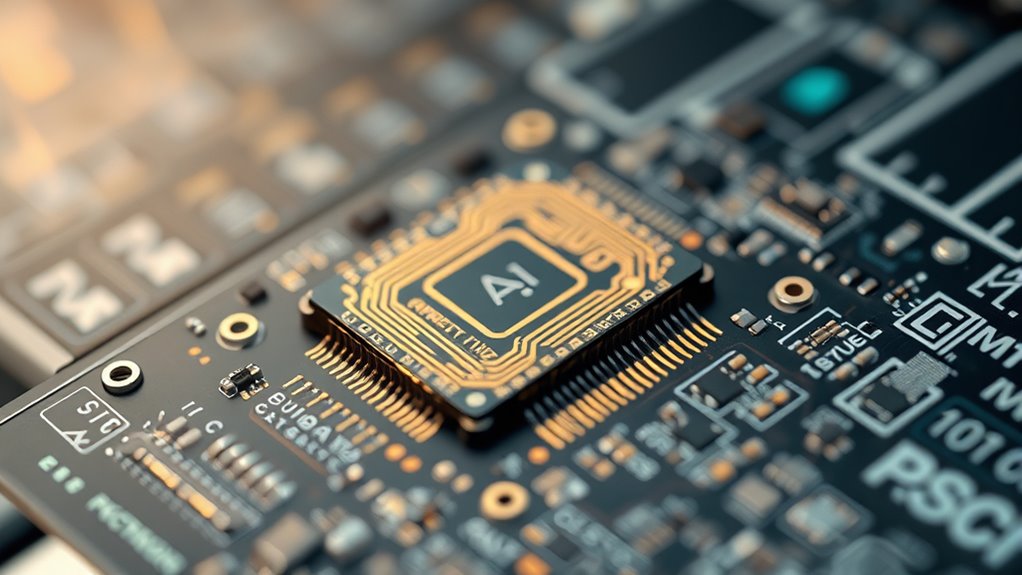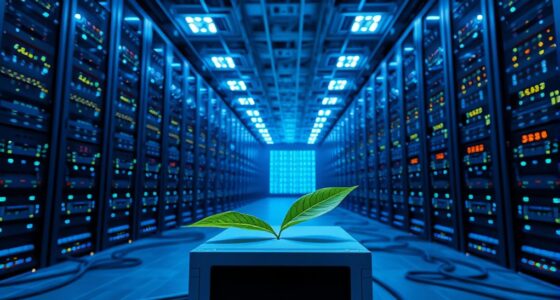Edge AI chips bring cloud-level smarts to tiny devices by allowing them to analyze data locally with specialized neural processing technology. This means your devices can handle complex tasks like voice recognition, facial identification, or real-time translation without relying on internet or cloud servers. They operate using minimal power, ensuring longer battery life and faster responses. Keep exploring how these chips are transforming small gadgets and boosting their intelligence even further.
Key Takeaways
- Edge AI chips enable local data processing, reducing dependence on cloud servers for faster, real-time decision-making.
- Neural processing technology allows complex analysis directly on tiny devices, matching cloud-level intelligence.
- They operate with high power efficiency, supporting long battery life in small, portable gadgets.
- Local processing enhances data privacy by minimizing data transmission and keeping sensitive info on the device.
- These chips expand smart functionalities to small devices, enabling offline operation and advanced features in compact form factors.

Have you ever wondered how smart devices process data so quickly without relying on the cloud? The secret lies in the incredible advancements of edge AI chips, which enable tiny devices to perform complex tasks locally. At the core of their efficiency is neural processing, a technology inspired by the human brain. Neural processing allows these chips to analyze data directly on the device, bypassing the need to send information over the internet to distant servers. This not only reduces latency but also enhances privacy because your data stays on the device. Instead of waiting for cloud-based systems to interpret data, edge AI chips can make instant decisions—think voice commands, facial recognition, or real-time language translation—all happening seamlessly in the background.
Edge AI chips perform lightning-fast data analysis locally, boosting privacy and efficiency without cloud dependence.
Power efficiency is another critical aspect that makes edge AI chips so revolutionary. Unlike traditional processors that consume significant energy, these chips are designed to operate with minimal power. They use specialized hardware tailored for neural processing, which means they can perform complex calculations without draining the device’s battery rapidly. This balance of high performance and low power consumption is essential for applications where size and energy availability are limited, such as wearable tech, smart cameras, and IoT sensors. You don’t need bulky power sources or frequent recharging; your device can stay functional longer while still delivering smart features. This efficiency isn’t just about conserving energy; it also reduces heat generation, allowing devices to remain compact and comfortable to use.
Edge AI chips also bring about a shift in how data is handled. Instead of transmitting vast amounts of raw data to the cloud, they process information locally, filtering and extracting only the necessary insights. This approach minimizes network traffic and prevents bottlenecks, making real-time responses faster and more reliable. Plus, with neural processing capabilities embedded directly into the device, you’re less dependent on an internet connection—your device can still perform smart functions even when offline. This independence enhances security and privacy, since sensitive data never needs to leave the device unless explicitly needed. Leveraging European cloud innovation further supports secure and sustainable data handling, ensuring data sovereignty and compliance with privacy standards.
In essence, edge AI chips are transforming tiny devices into powerful, efficient smart tools. By leveraging neural processing and optimizing power efficiency, they deliver cloud-level intelligence right at the edge of your network. Whether you’re using a smart watch, a home security camera, or a sensor in an industrial setting, these chips enable fast, private, and energy-efficient computing—bringing the full potential of AI where it’s needed most, right in the palm of your hand.
Frequently Asked Questions
How Do Edge AI Chips Impact Device Battery Life?
You might wonder how edge AI chips affect your device’s battery life. These chips enhance power efficiency by processing data locally, reducing the need for constant cloud communication. This means your device uses less energy, which can improve battery longevity. By handling tasks more efficiently, edge AI chips help your device run longer on a single charge, making them ideal for portable gadgets that demand both smart features and long-lasting power.
What Are the Security Concerns With Edge AI Chips?
Imagine your device as a fortress; edge AI chips open gates that could let threats in. Security concerns include vulnerabilities in data encryption, which might expose sensitive info, and weak access control, allowing unauthorized users to manipulate AI functions. You need robust security measures to protect your device’s data and guarantee only trusted sources can access the AI capabilities, safeguarding your privacy and device integrity.
Can Edge AI Chips Learn and Adapt Over Time?
You might wonder if edge AI chips can learn and adapt over time. The answer is yes—they use machine learning and adaptive algorithms to improve their performance locally. These chips process data on-site, allowing them to adjust to new patterns without needing cloud updates. This makes your devices smarter and more responsive, continuously improving as they gather more data, all while maintaining privacy and reducing latency.
How Do Edge AI Chips Compare Cost-Wise to Cloud Solutions?
You’ll find that edge AI chips are more cost-efficient than cloud solutions because they reduce ongoing data transmission and processing fees. Plus, they offer greater deployment flexibility, allowing you to implement them directly on devices without relying on constant internet connectivity. This setup saves money over time and provides faster, local processing. Overall, edge AI chips help you improve efficiency and flexibility while keeping costs lower than traditional cloud-based options.
What Industries Are Most Benefiting From Edge AI Chip Integration?
Imagine a surgeon performing diagnostics with a handheld device instead of a bulky machine—this is what edge AI chips enable. You’ll find industries like healthcare diagnostics and smart manufacturing benefiting most, as these chips bring cloud-level intelligence to tiny devices. They allow real-time analysis and decision-making without latency, revolutionizing patient care and factory productivity. As a result, industries become more efficient, responsive, and innovative.
Conclusion
As you embrace edge AI chips, you’ll realize they’re truly game-changers, bringing cloud-level intelligence to tiny devices. These chips allow you to process data locally, reducing latency and cutting costs. It’s clear that with these innovations, you’re not just keeping up—you’re staying ahead of the curve. Remember, in the world of tech, it’s often the little things that make the biggest difference. So, don’t overlook the power of these compact yet mighty chips.










